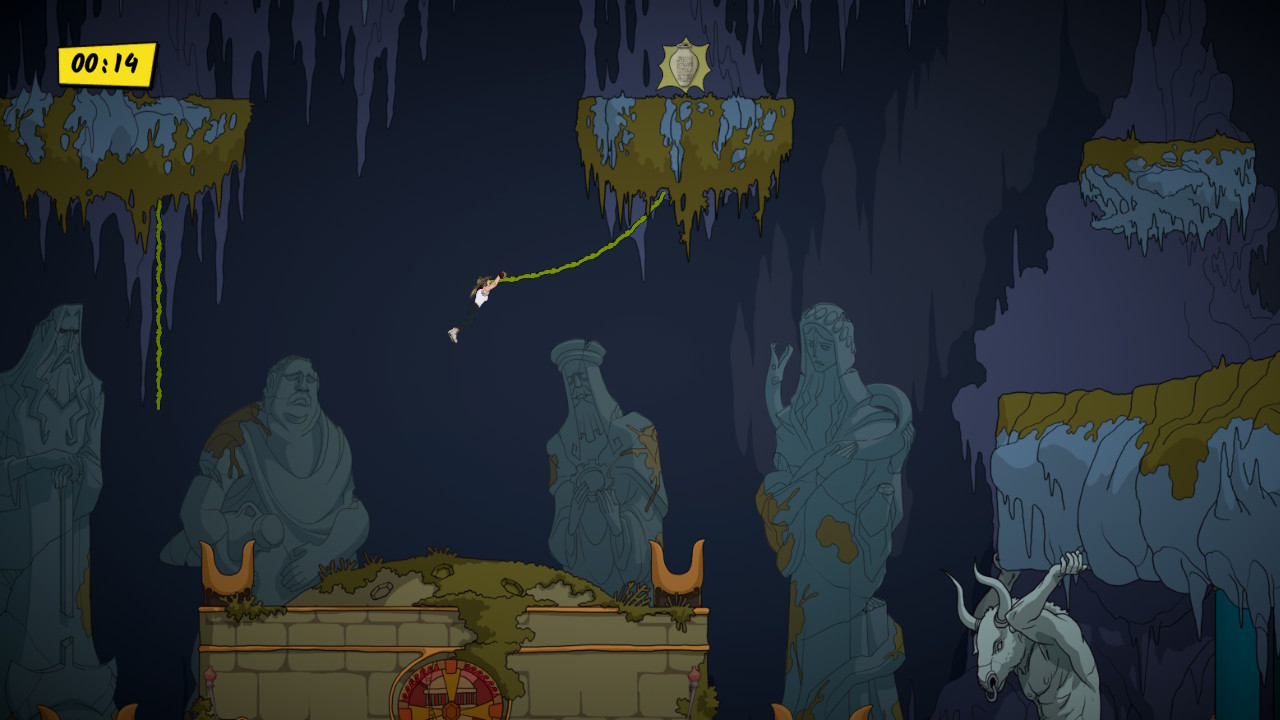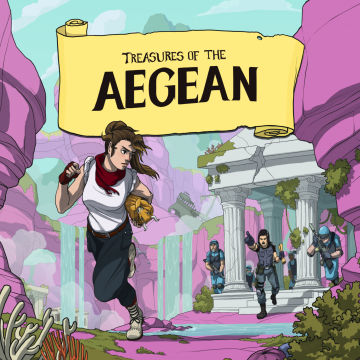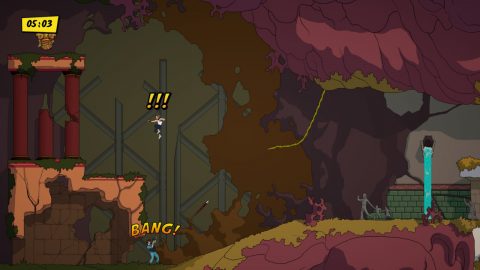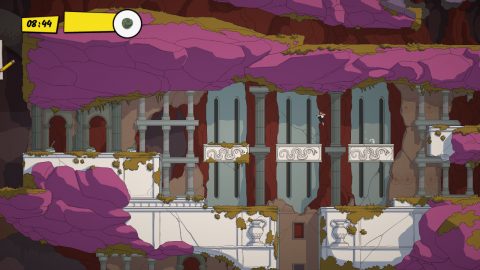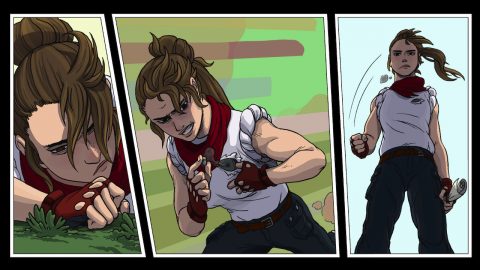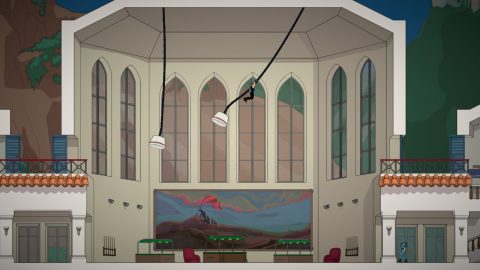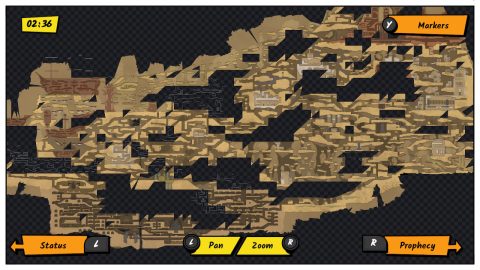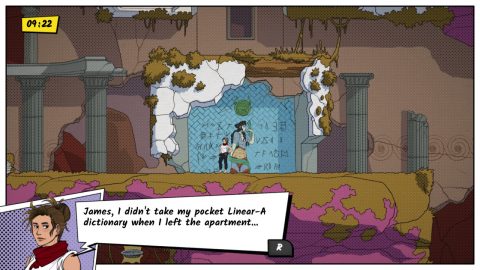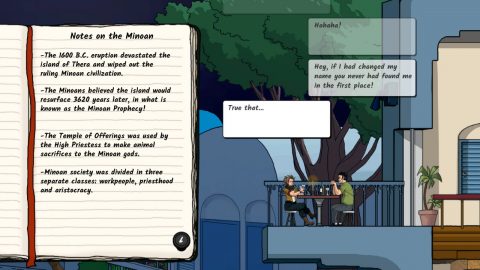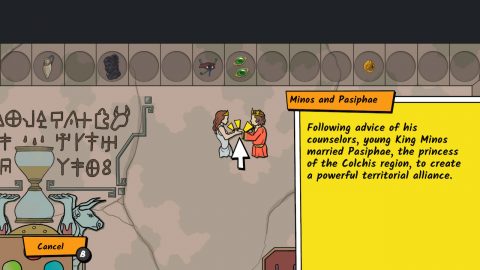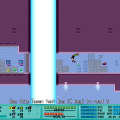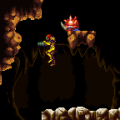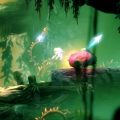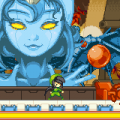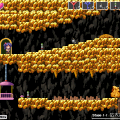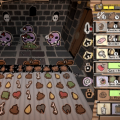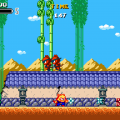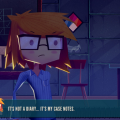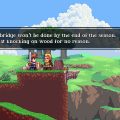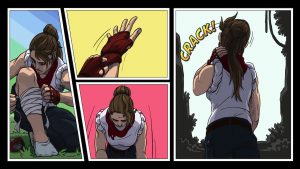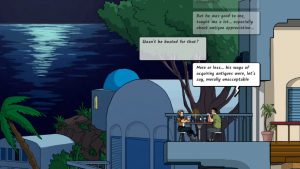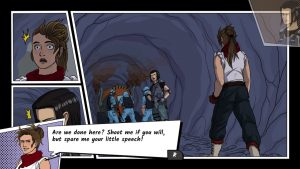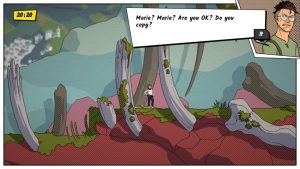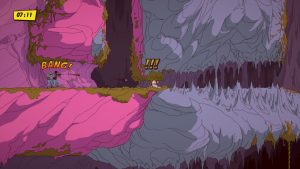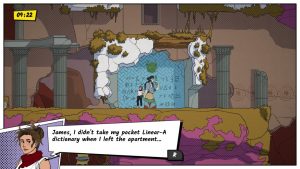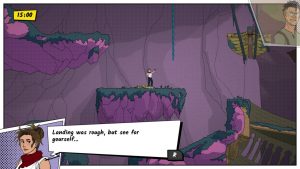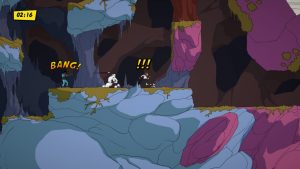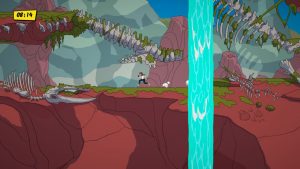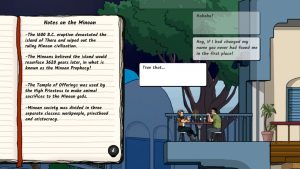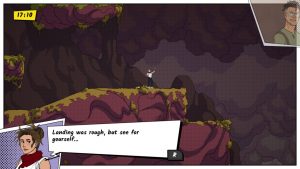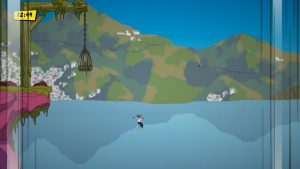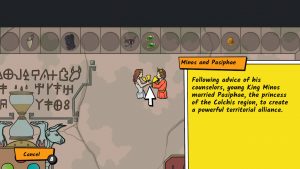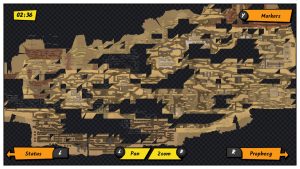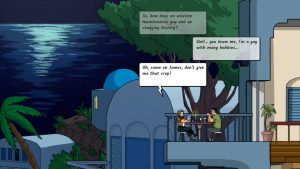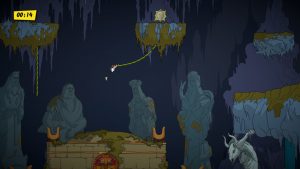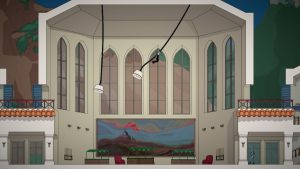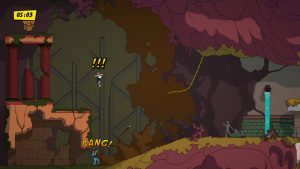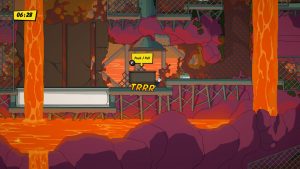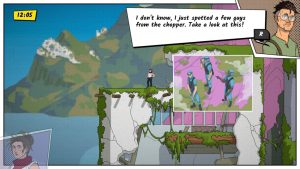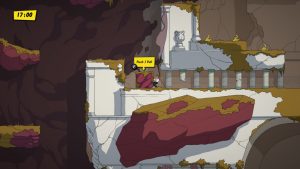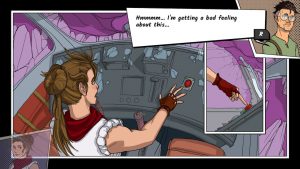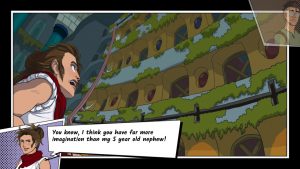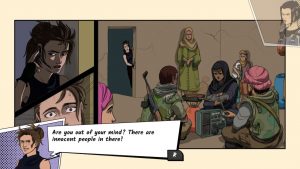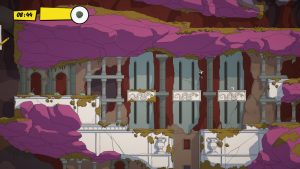Video games come in many genres, with their own established rules. We know what a puzzle platformer is, what a rougelike is, what an open world game is, and so on. But increasingly, genres are being combined together. An open world game is likely to also be an action-RPG, for instance. But occasionally we get that rare game that combines elements from a whole bunch of genres together into one, to create something that’s both familiar and yet unique.
Enter Treasures of the Aegean, an indie game from Spain. A 2D combination of parkour platformer, open world exploration game, cinematic platformer, and puzzle platformer, with slight roguelite elements, and simple controls.
The game is about a parkour master named Marie, and a historian named James, who are working together to collect treasures relating to the Minoan people of ancient Greece. Making things a bit more complicated are the people out to stop them, and the fact that they’re working on a time limit: there is a volcano which is going to erupt soon.
So, what’s the gameplay loop? Well, gameplay “loop” in this sense is actually quite literal!
Marie and James travel via helicopter to an island that suddenly mysteriously appeared out of thin air, and Marie lands in a random location. After using her phone camera to show James where she is, she sets out to explore. Being a parkour master, exploration involves a lot of running, jumping, climbing, sliding, crawling and swinging from vines. Marie moves very quickly, and it doesn’t take too long to learn how her abilities play out. She can only climb a very short distance before she starts to slip, and she can also slide down walls and wall-jump. She cannot fight in any way.
There are also levers to pull, objects such as carts and blocks to push and pull, ropes to cut, and other such environmental pieces which are used for puzzle design. Other puzzles are more elaborate and have very subtle hints written on the wall. There are also the typical platformer puzzles, such as pressing a button to open a slowly closing door so you can try to reach it and rush through before it slams shut, and things of that nature. There’s plenty of “how do I reach that?” moments and situations where a good understanding of the game’s mechanics is needed to reach some of the treasures. You can also bring up a map and mark locations to remind yourself of things that might be important for later. This becomes especially useful in the late game.
The world is open and spreads out in all directions. And there’s a lot of variety in the scenery too, including mountains, caves, giant snake statues that can be entered, towns, large buildings, jungles, and a lot more. And Marie has approximately 15-23 minutes to explore it to try and find as many treasures as she can, as well as anything else of interest that progresses the story or reveals more secrets of the Minoans.
Sometimes you’ll encounter a ghost, a statue, a puzzle, fresco on a wall, or some other object of interest which can result in a conversation between Marie and James, a cutscene, or a diary entry which can be read later. Puzzles range from platforming challenges such as “hit the switch to open the door and quickly parkour through before it closes” to some simple “pick this thing up and take it over there” situations.
During the main gameplay, Marie can’t be killed in the traditional sense – she has no life meter and doesn’t die. That’s not to say she’s truly invincible per se. If she falls from a great height or gets shot, she collapses, followed by a few comic book-style panels showing Marie recovering from her injury (such as pulling a bullet out of a bulletproof vest that she wears under her athletic outfit), before jumping back into the action with a minute docked from the timer.
So, what happens after 15 minutes? Well, the place goes boom. A quick cutscene plays out of Marie being called by James to get back onto his helicopter so they can get out of there, Marie dropping her phone, and a large volcano exploding, taking out nearly half the Earth! And then… time rewinds. Marie’s dropped phone somehow travels back in time and is discovered by the ancient Minoans.
And… it starts over again. Or does it? After each “loop” of exploration, there will sometimes be a cutscene showing Marie or James’ past, showing the armed bad guys that are also out to get the same treasures, or a flashback that fleshes out the story. Sometimes after these cutscenes, there will also be a short level that plays with very different rules.
These levels play differently from the open world gameplay. These tend to have goals or gimmicks. In one level, Marie needs to collect something from a guarded building, and then return to a boat. In another, she needs to outrun a spotlight from a pursuing helicopter as she parkours from building to building, trying to reach James.
Not only is there a goal and no time limit in these short flashback levels, Marie also dies in one hit.
After the level is complete, there’s a bit more story, and then we begin the next loop. First, you’re shown a screen displaying all the treasures obtained so far, and pictures of all discoveries relating to the Minoans and possible hints to the more complex puzzles. Moving the cursor over these provides a description of what each treasure or discovery is. Major discoveries that were made during exploration are added to a diary, detailing the information that’s been learned about the Minoans.
Once that’s done, Marie and James have a candlelight dinner and discuss various subjects ranging from their expedition to their shady pasts, before they head back to the island, with a repeat of the island approach cutscene (which can be skipped), and Marie in a different starting location to explore the open world once again. The map might even be more filled in with information it previously didn’t have.
And so it goes. Despite taking place in the same overall world, every loop potentially yields new discoveries and more progress. Sometimes new cutscenes, sometimes new non-open-world action levels. Sometimes new hints for the game’s more complex puzzles, some of which require a lot of exploring to solve. Sometimes locations in the world even lead to new cutscenes that progress the story, such as the discovery of shady characters from Marie’s past inside the world itself. There’s even a few hidden upgrades which require a lot of effort to obtain.
More time can be added to the timer from collecting treasures. And if you feel like a loop is going on for too long, you can simply end it from the status menu.
Some late game puzzles require a lot of traveling between different locations before time runs out! The game starts out being about simply collecting treasures that you can find all over the place through simple exploration, but eventually changes to being about having to really search for clues to solve increasingly elaborate puzzles and doing more complex platforming challenges. By the end, you’ll end up solving puzzles which connect to each other and require a great deal of platforming and traveling between different areas. Reaching the ending isn’t a matter of collecting all the treasures, but instead finding a specific location that requires a great deal of exploration, discovery and puzzle solving to be able to accomplish.
Treasures of the Aegean has a presentation all its own.
The game has a distinct comic book vibe to it, channeling the realistically drawn human character designs and limited color palettes reminiscent of various comic eras throughout the 20th century before digital coloring became the norm. Pop-up panels feature close-ups of the characters in conversation, and are used to illustrate cutscenes and highlight major discoveries. On-screen sound effects ripped straight from a comic book (BANG!) emphasize certain situations. As players make progress, the title screen changes slightly, displaying ‘Vol III’, ‘Vol IV’, and so on. There’s even the occasional appearance of comic book-style dots, similar to the “printed comic book” effect seen in the Spider-Verse movies.
Even with the simple colors, the visual elements that define each separate area are easy to spot, from large tree roots, to massive statues of snakes whose mouths serve as cave entrances, to blue caves filled with stalactites and stalagmites, to a crashed airplane. There’s just a great deal of visual variety in this comic book world.
The music, which is primarily ambient, changes to fit the different areas. The music starts out initially loud if not turned down, potentially drowning out another one of the game’s tricks for giving each location its own identity: ambient sounds, ranging from bird calls to waterfalls.
Adding more flavor to the experience is the frequent banter between Marie and James. While James isn’t coming along directly for the adventure, preferring to stay behind and see everything through Marie’s phone, he still has observations to give, as does Marie. The two talking back and forth not only add personality but even reveal more backstory, as both characters have shady pasts and connections to other shady characters, some of whom make appearances in the levels which take place in the past between the open world exploration, or even in the open world itself later on.
The open world itself is enormous and easy to get lost in, as open worlds often are, though starting in different locations on every loop does help make it easier to discover new things each time. The fact that each loop is a specific amount of time makes this a game which can be picked up for a semi-quick play session, though it’s important to realize that the timer freezes during conversations. If the game says you have 15 minutes to run through and discover as much as you can, expect to play for maybe 18-20 minutes instead, assuming you don’t take any damage. But if you’re looking for something you don’t need to dedicate too much time to per play session, this might fit nicely into your gaming schedule.
And there’s also the elements of history sprinkled throughout the game. The Minoans were a real people, Santorini is a real island, and many historical and mythological figures are mentioned by name. Every single treasure you collect can be read about in more detail on the “collected treasures” screen to learn about its historical significance, or the role it played in everyday Minoan life. You could Google search many of the things the game talks about to learn more about them!
On a parental note, there is talk of death and torture having occurred in the past, but never shown, other than a mural depicting the use of a brazen bull with no visible person shown inside. No blood is ever shown, even if Marie is shot. Bloodless corpses are occasionally seen. There’s occasional mild profanity of the “damn,” “hell” and “ass” variety, and one singular use of “bastard.” In terms of morality, Marie and Jack are treasure hunters, with both of them being interested in the historical aspects of their discoveries but with Marie caring more about the money. They do however have a clear sense of right and wrong – Marie shows some regret over her shady past and even anger at having been once told to do something that could have resulted in the deaths of innocents.
Treasures of the Aegean is a game with a style all its own, a very modern creation of the indie era, mixing ideas both old and new. While its parkour platformer elements and loop-based gameplay set it firmly in the modern era, the game also oddly evokes a feeling similar to old Atari 800 open world “collect all the treasures” platformers such as Pharaoh’s Curse and Pitfall. Combine that with the 20th century comic book style, and the use of smartphones, and you get something which is both a retro throwback and a modern product at the same time. Players looking for something new, and even older gamers looking for something which might evoke memories of their past, might both find something to like here.
